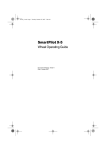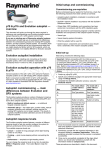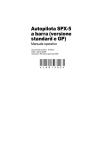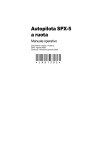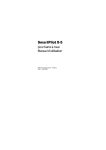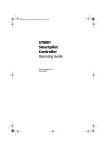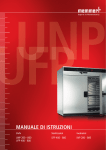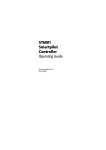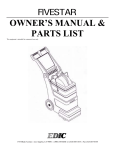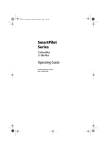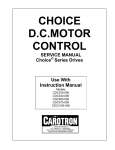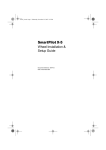Download Raymarine GyroPlus Yaw Sensor Setup guide
Transcript
SmartPilot X-5R Drive Operating Guide Document reference: 81329-1 Date: December 2010 Autohelm, hsb2, RayTech Navigator, Sail Pilot, SeaTalk, SeaTalkNG, SeaTalkHS and Sportpilot are registered trademarks of Raymarine UK Limited. RayTalk, Seahawk, Smartpilot, Pathfinder and Raymarine are registered trademarks of Raymarine Holdings Limited. FLIR is a registered trademark of FLIR Systems, Inc. and/or its subsidiaries. All other trademarks, trade names, or company names referenced herein are used for identification only and are the property of their respective owners. This product is protected by patents, design patents, patents pending, or design patents pending. Copyright ©2010 Raymarine UK Ltd. All rights reserved. i Contents Important Information ............................................................................................... iii Safety notices ..........................................................................................................iii EMC Conformance ..................................................................................................iii Pressure washing ....................................................................................................iv Product documents ..................................................................................................iv Product disposal ......................................................................................................iv Waste Electrical and Electronic (WEEE) Directive .....................................iv Warranty ..................................................................................................................iv Chapter 1:Basic Operation ...................................................................................... 1 1.1 Introduction .................................................................................................... 1 Extended systems .......................................................................................... 1 1.2 Using the control unit ..................................................................................... 2 Switching on and off........................................................................................ 2 Start-up mode ............................................................................................. 2 Keypad functions ............................................................................................ 2 Displayed information..................................................................................... 3 1.3 Using the SPX-5R Drive system to steer your boat ........................................ 4 Emergency release pin ................................................................................... 4 Replacing the pin after use ......................................................................... 4 Standby mode - steering by hand.................................................................... 4 Using the autopilot to steer to a heading ......................................................... 5 Changing course in Auto mode....................................................................... 5 AutoTurn ..................................................................................................... 6 Avoiding obstacles.......................................................................................... 6 Steering away ............................................................................................. 6 Selecting a change of course ..................................................................... 6 Off Course alarm ............................................................................................ 6 1.4 Adjusting pilot performance ........................................................................... 7 Response levels ............................................................................................. 7 Temporarily adjusting response.................................................................. 8 1.5 Display lighting & contrast .............................................................................. 8 Adjusting the display lighting........................................................................... 8 Contrast.......................................................................................................... 9 1.6 Data pages .................................................................................................... 9 Waypoint names........................................................................................... 10 1.7 Alarms ......................................................................................................... 10 Responding to alarms....................................................................................11 1.8 Response setup ........................................................................................... 12 Accessing response setup............................................................................ 13 Chapter 2:Using Track mode ................................................................................ 15 2.1 Overview ..................................................................................................... 15 Requirements for Track mode....................................................................... 15 Starting position and heading........................................................................ 15 2.2 Procedures .................................................................................................. 16 Entering track mode...................................................................................... 16 Leaving Track mode ..................................................................................... 16 Avoiding obstacles........................................................................................ 16 Track keeping & Cross Track Error ............................................................... 17 ii SmartPilot X-5R Drive Operating Guide Large cross track error.............................................................................. 18 Tidal stream compensation....................................................................... 18 Waypoint arrival ............................................................................................ 19 To steer to the next waypoint in the route................................................. 19 To skip a waypoint (SeaTalk chartplotters only) ....................................... 19 Waypoint arrival circle............................................................................... 20 Route completion.......................................................................................... 20 Chapter 3:Troubleshooting & Maintenance ..................................................... 21 3.1 Troubleshooting ........................................................................................... 21 SPX-5R Drive system alarm messages ........................................................ 22 3.2 Maintenance ................................................................................................ 23 Important ...................................................................................................... 23 Spare parts ................................................................................................... 23 EMC Servicing and maintenance.................................................................. 24 Suppression ferrites .................................................................................. 24 Pilot Controller .............................................................................................. 24 Drive ............................................................................................................. 24 Routine maintenance ................................................................................ 24 3.3 Customer support ........................................................................................ 26 Web support ............................................................................................. 26 Telephone and email support ................................................................... 26 Help us to help you ................................................................................... 26 Product details table ................................................................................. 27 Glossary ....................................................................................................................... 29 Index.............................................................................................................................. 31 iii Important Information Safety notices WARNING: Navigation aid Although we have designed this product to be accurate and reliable, many factors can affect its performance. Therefore, it should only be used as an aid to navigation and should never replace common sense and navigational judgement. Always maintain a permanent watch so you can respond to situations as they develop. CAUTION: Calibration When supplied, this product is calibrated to default settings which should provide initial stable performance for most boats. To ensure optimum performance on your boat, the commissioning procedures (in the SPX-5R Drive Installation & Setup Guide) must be completed before this product is used. Your Raymarine SPX-5R Drive system will add a new dimension to your boating enjoyment. However, it is the skipper’s responsibility to ensure the safety of the boat at all times by following these basic rules: • Ensure that someone is present at the helm AT ALL TIMES, to take manual control in an emergency. • Make sure that all members of crew know how to disengage the autopilot. • Regularly check for other boats and any obstacles to navigation – no matter how clear the sea appears, a dangerous situation can develop rapidly. • Maintain an accurate record of the boat’s position by using either a navigation aid or visual bearings. • Maintain a continuous plot of your boat’s position on a current chart. Ensure that the locked autopilot heading will steer the boat clear of all obstacles. Make proper allowance for tidal set – the autopilot cannot. • Even when your autopilot is locked onto the desired track using a navigation aid, always maintain a log and make regular positional plots. Navigation signals can produce significant errors under some circumstances and the autopilot will not be able to detect these errors. EMC Conformance All Raymarine equipment and accessories are designed to the best industry standards for use in the recreational marine environment. Their design and manufacture conforms to the appropriate Electromagnetic Compatibility (EMC) standards, but correct installation is required to ensure that performance is not compromised. iv SmartPilot X-5R Drive Operating Guide Pressure washing Subjecting any Raymarine product to high pressure washing may cause subsequent water intrusion and failure of the product. Raymarine will not warranty product subjected to high pressure washing. Product documents This document is part of a series of books associated with the SmartPilot X-5 series. Documents can be downloaded from: www.raymarine.com/handbooks. Title Part number SmartPilot X-5R Drive Installation and Setup Guide 87128 ST6002 SmartPilot Controller - Quick Reference Guide 86140 Fluxgate Compass Installation sheet 87011 To the best of our knowledge, the information in the product documents was correct when they went to press. However, Raymarine cannot accept liability for any inaccuracies or omissions in product documents. In addition, our policy of continuous product improvement may change specifications without notice. Therefore, Raymarine cannot accept liability for any differences between the product and the accompanying documents. Product disposal Waste Electrical and Electronic (WEEE) Directive The WEEE Directive requires the recycling of waste electrical and electronic equipment. Whilst the WEEE Directive does not apply to some of Raymarine's products, we support its policy and ask you to be aware of how to dispose of this product. The crossed out wheelie bin symbol, illustrated above, and found on our products signifies that this product should not be disposed of in general waste or landfill. Please contact your local dealer, national distributor or Raymarine Technical Services for information on product disposal. Warranty To register your new Raymarine product, please take a few minutes to register online at www.raymarine.com. 1 Chapter 1: Basic Operation 1.1 Introduction The SmartPilot X-5 (SPX-5R) Drive system is intended for use as an aid to steering leisure marine craft with a fully-laden displacement up to a maximum of: • 4400 pounds (2000 kg) for mechanically steered craft. • 7500 pounds (3500 kg) for power steered craft. ST6002 Pilot Controller Course Computer Drive unit Fluxgate compass D10702-2 Your SPX-5R Drive system is controlled by a Raymarine ST6002 Pilot Controller (supplied), and operates in the following modes: • Standby: SmartPilot off. You have manual control of the boat. • Auto: The SmartPilot steers the boat to maintain a locked heading. • Track: The SmartPilot steers the boat to maintain a track between two waypoints created on a navigation aid. The SPX-5R Drive system also provides: • Enhanced course keeping using AST (Advanced Steering Technology). • AutoLearn, Raymarine’s self-learning calibration system. Extended systems You can connect the Pilot Controller to other Raymarine SeaTalk equipment so it can send and receive SeaTalk data. The Pilot Controller uses: • Waypoint information from a SeaTalk navigation instrument to provide track control. • Boat speed information from a SeaTalk speed instrument to optimize trackkeeping performance. You can also use the SPX-5R Drive system with SeaTalkng (refer to the SeaTalkng Reference Manual), or with any navigator or instrument that transmits National Marine Electronics Association (NMEA) 0183. The SPX-5R Drive system is also compatible with NMEA2000 data, accessed via SeaTalkng. The Pilot Controller can display SeaTalk and NMEA instrument data in a user-defined selection of data pages. 2 SmartPilot X-5R Drive Operating Guide For further information on other connections to your system refer to the SmartPilot X-5R Drive Installation & Setup Guide. 1.2 Using the control unit Switching on and off When power is applied to the Pilot Controller, you can use the disp button to switch it off and on as follows: • To switch the Pilot controller off, ensure it is in the Standby mode, then hold down disp for approximately 5 seconds. After this time, a switch off count down of 4 seconds occurs. Keep disp pressed during this period, to switch off the instrument. disp for approximately 1 second. • To switch the instrument back on, hold down If power is not applied, the Pilot Controller buttons have no effect. Notes: (1) Each time power to the Pilot Controller is switched on, the controller is initially in the on condition. You do not need to use disp to switch the controller on. disp initiates other operating (2) When the controller is on, the operation of functions, as described below. Start-up mode The SPX-5R Drive system always powers up in Standby mode with the Pilot Controller display showing the boat’s current compass heading. Keypad functions The SPX-5R Drive system is controlled by button presses at the Pilot Controller. Button operation is confirmed with a short beep. Single-button and dual-button operations are used. -1 plus -10 Press together for 90˚ AutoTurn to port -1 plus +1 Press for Response level track Press for Track mode from Auto (if a navigator is connected) Press to accept waypoint advance Press for 1 second to skip waypoint disp Press to display data pages Press for 1 second for lamp adjust Press for 3 seconds for contrast adjust Press for 9 seconds (in Standby mode) for power down When powered down, press for 1 second to power up standby Press for Standby mode Press for 2 seconds to enter Calibration mode +1 plus +10 Press together for 90˚ AutoTurn to starboard Course change keys Port 1˚ Starboard 1˚ Port 10˚ Starboard 10˚ auto Press for Auto mode D10690-1 Chapter 1: Basic Operation 3 Displayed information The Pilot Controller display screen provides the following information: Variable text region (up to 9 characters/digits) Port and Starboard direction-to-steer indicators nm SM MAG TRUE Heading indicators Distance units: • no units = kilometres • nm = nautical miles • SM = statute miles Rudder position indicator. Displayed only if the optional rudder reference transducer is fitted to the autopilot system. Otherwise, this area is blank. D10910-1 If the optional Rudder Reference Transducer is fitted to an SPX-5R Drive system, a rudder position indicator on the display indicates the current position of the rudder, as measured by the transducer. The rudder position indicator can be turned on or off during display calibration (see the SmartPilot X-5R Drive Installation & Setup Guide for details). 4 SmartPilot X-5R Drive Operating Guide 1.3 Using the SPX-5R Drive system to steer your boat WARNING: Maintain a permanent watch Automatic course control makes it easier to steer a boat, but it is NOT a substitute for good seamanship. ALWAYS maintain a permanent watch by the helm. Emergency release pin In the unlikely event of a steering failure, remove the release pin as shown to take manual control of the vessel. After removing the pin the drive and attached part of the torque restraint will rotate. Hold the torque restraint away from the dashboard to avoid contant with any protruding objects. Replacing the pin after use • Inspect the Pin and R-Clip for any wear or damage prior to re-use. Standby mode - steering by hand At any time you wish to take manual control of the vessel and disengage the autopilot: • press the standby key. Chapter 1: Basic Operation 5 TRUE D10524-1 In Standby mode: • You have manual control of the boat. • The display shows STANDBY and the boat’s current compass heading. Using the autopilot to steer to a heading Before engaging the autopilot, ensure you can steer the boat satisfactorily by hand, then steady the boat on the required heading. To engage the autopilot for automatic steering: • Press the auto key. The SPX-5R Drive system will steer the boat on the chosen heading, which is shown on the display. This mode is also known as “point-and-shoot”. TRUE D3560-6 Changing course in Auto mode In Auto mode, use -1, -10, +1 and +10 to change the locked heading, in either 1° or 10° steps.Use -1 or -10 to apply changes to port and +1 or +10 for changes to starboard. For example: press -10 three times for a 30° course change to port. Port Starboard or or D11366-1 6 SmartPilot X-5R Drive Operating Guide AutoTurn In Auto mode, you can carry out an AutoTurn of 90° by pressing -1 and -10 for an AutoTurn to port, or +1 and +10 for an AutoTurn to starboard. Avoiding obstacles When your boat is under autopilot control, you can change course to avoid the obstacle, then resume your previous course. You can either: • Manually steer away from the obstacle immediately. This is especially useful when a quick course change is required, e.g. in an emergency situation. or • Use -1, -10, +1 and +10 to change the locked heading. Obstacle Original course Dodge D10692-1 Steering away The preferred method for steering away from obstacles is: 1. Press standby, to return to Standby mode. 2. Manually turn the wheel to steer away from the obstacle. 3. Press auto to re-engage Auto mode If you do not have time to engage Standby mode (e.g. in an emergency), manually turn the steering wheel to steer away from the obstacle, whist still in Auto mode. When you have passed the obstacle, press standby then auto, to re-engage Auto on the previous locked heading. Selecting a change of course 1. Use -1, -10, +1 and +10 to select a change of course in the appropriate direction. For example, press -10 three times for a 30°dodge to port. 2. When you are safely clear of the obstacle, reverse the previous course change. For example, press +10 three times to reverse a 30°dodge to port. Off Course alarm If you have been off course from the locked heading for longer than 20 seconds, an alarm sounds and the Pilot Controller shows whether the deviation is to port or starboard. Chapter 1: Basic Operation 7 = deviation to port = deviation to starboard D3315-5 To cancel an Off Course alarm, press standby to return to manual steering. If the heading recovers or if you change course, the alarm clears automatically. Note: The default off course angle is set at 20º. You can adjust this angle in Dealer Calibration (see SmartPilot X-5R Drive Installation & Commissioning Guide). 1.4 Adjusting pilot performance The principal method of adjusting the performance of an SPX-5R Drive system is by changing the response level. This controls the relationship between the course keeping accuracy of the SPX-5R Drive system, and the amount of helm/drive activity. Changing the response level should be the only adjustment you need to make to your SPX-5R Drive system on a regular basis. When you first turn on your SPX-5 Drive system after installation, the response will initially be set to the default level of 5, but you can change this level in User Calibration (refer to your SmartPilot X-5R Drive Installation & Setup Guide for details). Changes made using user Calibration will be retained when the SPX-5R Drive system is switched off. You can also make temporary adjustments to the response level to quickly match performance to changing conditions. Note however that these temporary changes to response level will be lost when the system is powered off, with the default value being reapplied when the system is next switched on. Response levels As a general rule, higher response values give tighter course keeping (e.g. for pilotage in confined and sheltered waters). Lower values reduce drive activity and conserve battery power. The SPX-5R Drive system has nine levels of response: • Levels 9 to 7 give the tightest course keeping and greatest rudder activity (and power consumption). This can lead to a rough passage in open waters as the SPX-5R Pilot may ‘fight’ the sea. • Levels 6 to 4 should give good course keeping with crisp, well controlled turns under normal operating conditions. • Levels 3 to 1 minimize the amount of pilot activity. This conserves power, but may compromise short-term course-keeping accuracy. 8 SmartPilot X-5R Drive Operating Guide Temporarily adjusting response Decrease response Increase response D10527-1 To make temporary adjustments to the response level as required: 1. Press and release -1 and +1 simultaneously, to display the RESPONSE screen. Note: The RESPONSE screen is set as a default data page (see SmartPilot X-5R Drive Installation & Setup Guide), so you can also access it by pressing disp and then scrolling through the data pages. 2. Press -1 or +1 to change the response level. 3. Press disp or wait for 5 seconds to return to the previous display. Note: You will lose temporary changes to response level when the system is powered off. You can make permanent adjustments in User Calibration. 1.5 Display lighting & contrast Adjusting the display lighting To adjust the display and keypad lighting: 1. Hold down disp for 1 second from any mode to access the LAMP screen and turn on the lights. . 1 second D10528-1 2. Press disp to cycle through the possible illumination settings: LAMP 3 (the brightest setting), LAMP 2, LAMP 1, OFF, LAMP 1, LAMP 2, LAMP 3 and so on. As you change the setting, the illumination on any other SeaTalk instruments or control units will also change. Chapter 1: Basic Operation 9 3. The display automatically returns to the previous mode if you do not press a button for 10 seconds. If you press another mode button within 10 seconds you will select the associated mode. For example: auto selects Auto mode, standby selects Standby mode. Notes: (1) You can also adjust the lighting level from other SeaTalk instruments or control units. (2) When you switch off, any changes you have made to the lighting level will be lost. Contrast To set the display contrast level: 1. With the autopilot in Standby mode, hold down disp for one second to access the LAMP screen. 2. Hold down disp for one second again, to display the CONTRAST screen. 3. Use +1 and -1 to set the required contrast level (from 1 to 15). 4. The display automatically returns to the previous mode if you do not press a button for 10 seconds. If you press another mode button within 10 seconds you will select the associated mode. For example: auto selects Auto mode, standby selects Standby mode. 1.6 Data pages A series of data pages on the Pilot Controller enables you to quickly monitor various information from your SPX-5R Drive system. To access these data pages: 1. Press disp to access the first data page. 2. Press disp again to cycle the next data page, then continue this process to reach the page you want. 3. When all pages have been displayed and you press disp again, the display returns to the current SPX-5R Drive system mode screen (for example, AUTO). When you first use your SPX-5R Drive system, four data pages are available, as in the following illustration, but you can configure up to fifteen data pages during Display calibration, as detailed in the SPX-5R Drive Installation & Commissioning Guide. 10 SmartPilot X-5R Drive Operating Guide Default data pages Data page 4 Data page 1 Autopilot mode Press for 1 sec to return to previous data page Data page 3 Data page 2 D10533-1 If the required information is not available for any data page, dashes are displayed. Most data pages show repeated data so are for information only; you cannot adjust the values on them. An exception to this is the RESPONSE page, where you can adjust the value using the -1 and +1 buttons. Waypoint names If waypoints have been given names, the Pilot Controller will display them on the Cross Track Error (XTE), Bearing To Waypoint (BTW) and Distance To Waypoint (DTW) data pages: • Waypoint names of five characters or less are displayed together with the page name (as shown by screen A below). • Waypoint names of more than five characters alternate with the page name (as shown by screen B below). • If a waypoint name has more than nine characters, the display only shows the first nine characters. TRUE TRUE TRUE A B D10535-1 1.7 Alarms The SPX-5R Drive system supports the alarms listed on the following pages. When an alarm occurs, a beep sounds and the appropriate alarm message is displayed. Chapter 1: Basic Operation 11 Responding to alarms • • Unless otherwise stated, if an alarm occurs, press standby to clear the alarm and return to hand steering. If more than one alarm occurs, as each alarm is cleared, the next is displayed. Message Description and possible actions LARGE XTE Large cross track error Occurs if the cross track error exceeds 0.3 nm. The alarm clears if the heading recovers. MOB Man OverBoard alarm The SPX-5R Drive system activates the Man Overboard alarm if it receives a man overboard (MOB) message from another instrument on the SeaTalk system. It displays the text MOB instead of the waypoint number on the XTE, DTW and BTW data pages. If the autopilot is in Track mode, it will sound the Waypoint Advance alarm to notify you of the change in waypoint. NEXT WPT Waypoint advance alarm The SPX-5R Drive system activates the Waypoint Advance alarm whenever the target waypoint changes. This occurs when: • you select automatic acquisition by pressing track from Auto • you request waypoint advance by pressing track for 1 second in Track mode (with SeaTalk navigators only) • the boat arrives at the target waypoint and the navigator accepts the next waypoint • you activate the Man Overboard (MOB) function in Track mode When the alarm sounds, the pilot continues on its current heading but displays: • the bearing to the next waypoint • the direction the boat will turn to take up that bearing NEXT WPT Responding to a Waypoint Advance alarm To respond to a Waypoint Advance alarm: • check that it is safe to turn onto the new track, then press track to accept the waypoint advance • alternatively, you can cancel the alarm without accepting the waypoint advance by pressing: standby to return to hand steering, or auto to return to Auto mode. (continued) Note: Waypoint advance only operates if the SPX-5R Drive system is re- ceiving valid bearing to waypoint and waypoint number information. OFFCOURSE (PT or Stb) Off course alarm Occurs if the vessel has been off course from the locked heading for longer than 20 seconds. • PT = Deviation to port • Stb = Deviation to starboard You can adjust the specified alarm angle in Dealer setup, see your Commissioning guide for details. If this happens frequently you should review autopilot performance. Seepage 7. SHALLOW Shallow alarm The SPX-5R Drive system activates the Shallow alarm if it receives a shallow depth alarm via SeaTalk: • press standby or disp to cancel the alarm 12 SmartPilot X-5R Drive Operating Guide 1.8 Response setup The response level controls the relationship between course keeping accuracy and the amount of helm/drive activity. User setup functions are accessed using a User calibration mode. Information on other setup functions is given in the SmartPilot X-5R Drive Installation & Setup Guide. Note: You can also make temporary changes to response during normal operation, as described earlier in this Chapter. Screen Text Options RESPONSE Range = 1 to 9 . Levels 9 to 7 give the tightest course keeping and greatest rudder activity (and power consumption). This can lead to a rough passage in open waters as the SPX Wheel system may ‘fight’ the sea. Levels 6 to 4 should give good course keeping with crisp, well controlled turns under normal operating conditions. Levels 3 to 1 minimize the amount of pilot activity. This conserves power, but may compromise short-term course-keeping accuracy. Chapter 1: Basic Operation 13 Accessing response setup You can access the User calibration mode only from Standby mode, so to set the response level: 1. Ensure the SPX-5R Drive system is in Standby mode, then hold down standby for 2 seconds. The display will change to show DISPLAY CAL. 2. Press disp once. The display will now show USER CAL. 3. Press auto to enter User calibration. The Response setup page is displayed. 4. To access other User calibration pages, press disp to scroll through the calibration functions (described below). 5. Use the -1, +1, -10 and +10 buttons to change the value of each function you want to change. 6. When you have made all the changes you want to make, hold down standby for two seconds to exit calibration mode and save changes. 14 SmartPilot X-5R Drive Operating Guide 15 Chapter 2: Using Track mode 2.1 Overview Your SPX-5R Drive system provides a Track mode, to enable you to automatically follow a route (or track), set on your chartplotter or GPS. A track is a predefined path through a series of waypoints with each “track leg” being a straight line between 2 consecutive waypoints. Waypoint D10915-1 Track leg In Track mode, the SPX-5R Drive system will make any course changes necessary to keep your boat on the required track, and automatically compensate for tidal streams and leeway. Requirements for Track mode To operate in Track mode, the SPX-5R Drive system must receive route information from a suitable navigation system, such as: • A SeaTalk compatible chartplotter or GPS unit. • An NMEA 0183 or NMEA2000 compatible chartplotter or GPS unit. • A SeaTalkng compatible chartplotter. Refer to the SmartPilot X-5R Drive Installation & Commissioning Guide for connection details. Starting position and heading Before entering Track mode, ensure that the boat is as close as possible to the actual track and course heading (see Track keeping & Cross Track Error on page 17.). When you enter Track mode, the SPX-5R Drive system will steer the boat onto the required track. 16 SmartPilot X-5R Drive Operating Guide 2.2 Procedures Entering track mode Starting with the SPX-5R Drive system in Auto mode and your chartplotter or GPS set to follow a route, enter track mode as follows: 1. Press track to enter Track mode. 2. The autopilot will sound an alarm and the display will show information regarding the next planned waypoint. 3. Check that it is safe for the boat to turn onto the new course, then press track again. The SPX-5R Drive system will turn the boat onto the new course and the display will show the heading required to achieve the required track. Note: If the boat is more than 0.3 nm from the track, a Large Cross Track Error warning will sound (see page 18). Waypoint arrival and advance Next target Waypoint at 270˚ Target Waypoint New target waypoint at 270˚ Old target Waypoint TRUE Waypoint arrival Waypoint advance D10693-1 TRUE Leaving Track mode You can leave Track mode at any time. To do this, either: • Press auto to return to Auto mode. or • Press standby to take manual control of the boat. Avoiding obstacles In Track mode you still have full control from the keypad. You can change course to avoid obstacles by manually steering away from the obstacle or by using the course change buttons (-1, +1, -10 or +10). When manually steering around an obstacle,the preferred method is to: 1. Press standby, to return to Standby mode. 2. Manually turn the wheel to steer away from the obstacle. Chapter 2: Using Track mode 17 3. Press auto to re-engage Auto mode. If you do not have time to engage Standby mode (e.g. in an emergency), manually turn the steering wheel to steer away from the obstacle, whist still in Track mode. When you have passed the obstacle, press standby then auto, to re-engage Auto on the previous locked heading. Once you are safely past the obstacle, either: • Return to your previous planned track, by pressing track then responding to the NEXT WPT message by pressing track again or • Use your chartplotter to initiate a new route to the waypoint. Track keeping & Cross Track Error Cross track error (XTE) is the distance of the vessel from the planned track. An XTE can be generated if: • You enter Track mode when positioned some distance from the planned route. • You make a manual course change to avoid an object. • You arrive at a waypoint (see page 20). CAUTION: When entering or returning to Track mode the heading will initially be BTW, but may change slightly as the autopilot removes the XTE, to achieve the defined track leg. Course correction Example 1: Initial turn toward waypoint Target Waypoint Example 2: Initial turn away from actual waypoint position. Target Waypoint Cross track error TRUE TRUE D10909-1 Cross track error 18 SmartPilot X-5R Drive Operating Guide Best practice track keeping demands that the vessel follows the predefined Track Leg as closely as possible. This is to avoid potential collision with charted objects that may be near the defined path The Raymarine Track keeping algorithm ensures safe operation by correcting any XTE as quickly as possible, but with a maximum convergence angle of 30º with the Track Leg. It then maintains the vessel tightly on the desired track. Large cross track error If a cross track error of greater than 0.3 nm occurs, the SPX-5R Drive system will sound a Large Cross Track Error warning and the Pilot Controller will show whether you are to the port (Pt) or starboard (Stb) of the planned track. Cross track error (XTE) more than 0.3 nm e out al r u Act Waypoint 2 ed te rou D10695-4 nn Pla Waypoint 1 Tidal stream compensation Under most conditions, the SPX-5R Drive system will hold the selected track to within ±0.05 nm (300 ft) or better. It takes account of the boat’s speed when computing course changes to ensure optimum performance. Waypoint 2 Boat's speed over ground Tidal component Boat's speed through water Waypoint 1 D10696-1 Chapter 2: Using Track mode 19 Waypoint arrival As your vessel nears the waypoint, an audible Waypoint Advance warning sounds and a next waypoint (NEXT WPT) screen is displayed. This shows the bearing to the next waypoint. . Waypoint arrival and advance Next target Waypoint at 270˚ New target waypoint at 270˚ Old target Waypoint Target Waypoint TRUE Waypoint arrival Waypoint advance D10693-1 TRUE WARNING: Ensure safe navigation Before changing course, always ensure it is safe to do so. Always be aware of the relative wind angle, especially when turning away from the wind. To steer to the next waypoint in the route When the Waypoint Advance warning sounds, the SPX-5R Drive system suspends Track mode and maintains the current boat heading.To advance to the next waypoint: 1. Check that it is safe to turn onto the new track. 2. Press the track button, to cancel the Waypoint Advance warning and steer the boat to the next track leg. Note: If you do not press track to accept the Waypoint Advance, the SPX-5R Drive system will maintain the current heading and continue to sound the warning. To skip a waypoint (SeaTalk chartplotters only) If you want to advance to the next waypoint before you have arrived at the current target waypoint, you can skip the current waypoint by pressing track for 1 second. The display will then show a Waypoint Advance screen for the next waypoint. Check it is safe to turn, then press track to turn the boat towards the next waypoint. 20 SmartPilot X-5R Drive Operating Guide Waypoint arrival circle As the next Waypoint warning occurs within a circle around the actual waypoint, the next waypoint will probably be accepted some distance from the planned track leg. This can result in a cross track error and associated course correction. Refer to Track keeping & Cross Track Error on page 17 for more details. Next Waypoint Planned track leg Actual bearing to next waypoint from waypoint acceptance position Waypoint arrival circle Next waypoint accepted here D10697-1 XTE Route completion when you have reached the last waypoint of a route in Track mode, the Pilot Controller displays a ROUTE COMPLETE message if you are using a SeaTalk chartplotter, or NO DATA if you are using an NMEA chartplotter. You can either: • Stay in Auto mode and continue on the same heading. or • Press standby to return to manual control. Note: If waypoints are provided using an NMEA connection the controller will display NO DATA when you reach the final waypoint. 21 Chapter 3: Troubleshooting & Maintenance This chapter provides information to enable you to identify problems, interpret alarm messages, maintain your SPX-5R Drive system and obtain product support. Raymarine products are designed to provide many years of trouble-free operation. They are also put through comprehensive testing and quality assurance procedures before shipping. However, if a problem occurs with your SPX-5R Drive system, use the troubleshooting tables in this section to help identify the problem and provide a solution. If you cannot resolve the problem yourself, refer to the product support information. 3.1 Troubleshooting Symptom Possible cause and remedy Display is blank No power – check the power and SeaTalk fuses on Course Computer, then check main fuse/circuit breaker. Data page display shows stationary dashes The Pilot Controller is not receiving necessary data from other instruments – check cabling. Display shows rotating dashes Compass calibration in progress (see SmartPilot X-5R Drive Installation & Setup Guide). Displayed compass heading does not agree with the boat’s compass You have not calibrated the compass. Carry out the deviation and alignment procedures (see SmartPilot X-5R Drive Installation & Setup Guide). Drive getting hot Manually check that the steering system operates comfortably and that it is not being overloaded. Boat turns slowly and takes a long time to come onto course Manually check that the steering system operates comfortably and that it is not being overloaded. If this is OK, the rudder gain may be too low. Complete AutoLearn or increase gain setting (see SmartPilot X-5R Drive Installation & Setup Guide). Boat overshoots when turning onto a new course Rudder gain too high. Complete AutoLearn or decrease gain setting (see SmartPilot X-5R Drive Installation & Setup Guide). The SPX-5R Drive system ‘hunts’ when trying to position the rudder Adjust the RUDD DAMP setting (see SmartPilot X-5R Drive Installation & Setup Guide). Increase the damping one level at a time until the autopilot stops hunting. Always use the lowest acceptable value. You cannot enter Seatrial Calibration Seatrial calibration lock is on – turn off the calibration protection feature in Dealer Calibration (see SmartPilot X-5R Drive Installation & Setup Guide). The SPX-5R Drive system will Cabling problem – make sure all the cables are connot ‘talk’ to other SeaTalk instru- nected properly. ments 22 SmartPilot X-5R Drive Operating Guide Symptom Possible cause and remedy Navigation information not received Navigator not transmitting the correct data. Ensure system cables are securely connected. The SPX-5R Drive system will not auto advance to the next waypoint No bearing to waypoint information received from the navigator. SPX-5R Drive system alarm messages If a fault or failure occurs in the SPX-5R Drive system, an appropriate alarm message is generated. If this happens and unless otherwise stated, press standby to clear the alarm and return to manual control, before you attempt to resolve the problem. If more than one alarm occurs, as each alarm is cleared, the next is displayed. Alarm messages, possible causes and remedies are detailed in the following table. Alarm message Possible cause and remedy CURRENT LIMIT Serious drive failure – the drive is taking too much current due to short-circuit or jamming. Check the drive unit. DRIVE STOPPED The SPX-5R Drive system is unable to turn the rudder. This can occur if the weather load on helm is too high, or if the (optional) rudder position sensor has passed beyond the preset rudder limits or rudder endstops. Manually check that the steering system operates comfortably and that it is not being overloaded. Check drive and, if appropriate, the rudder position sensor.. LOW BATTERY Supply voltage has dropped below acceptable limits. • press standby to clear the alarm and return to hand steering • start the engine to recharge the battery • ensure the charging system is working correctly. LRN FAIL (code) AutoLearn not completed successfully. Failure codes: 1 = AutoLearn has not been carried out (default setting) 2 = AutoLearn failed, usually due to manual interruption 3 Not used 4 = AutoLearn failed, probably due to drive or compass failure 5 = AutoLearn failed, probably due to motor current limiting 6 = AutoLearn failed, probably due to boat spinning Repeat the AutoLearn procedure (see SmartPilot X-5R Drive Installation & Setup Guide). MOT POW SWAPPED Motor cables are connected to power terminals (and power cables are connected to motor terminals) at Course Computer. Turn off power and swap over connections. Chapter 3: Troubleshooting & Maintenance 23 Alarm message Possible cause and remedy NO DATA Caused by any of the following situations: • the compass is not connected • the SPX-5R Drive system is in Track mode and: • is not receiving navigation data, or • the position sensor (GPS) is receiving a low strength signal – problem will clear when the signal improves Check connections to the compass and navigator. Note: The SPX-5R Drive system stops adjusting the heading as soon as it loses data. NO PILOT The Pilot Controller is not receiving data from the SPX-5R Drive system computer. Check connections and check the Course Computer is switched on. NO RUDREF Only applicable if rudder reference option is fitted. Possible fault with rudder position sensor – check connections. RG FAIL GyroPlus yaw sensor has failed. Call a Raymarine service agent. NO SPD No speed data. NO COMP No compass data. NO WIND No wind data. SEATALK and FAIL The Pilot Controller cannot transmit data to the SeaTalk system. Make sure all SeaTalk cables are connected properly. 3.2 Maintenance Important Before attempting any maintenance procedure on the SPX-5R Drive system, ensure the boat is securely moored alongside and that power to all system components is switched off. CAUTION: Avoid damage when cleaning Do NOT use solvent or abrasive cleaners on any SPX-5R Drive system components. Spare parts CAUTION: Do not dismantle SPX-5R Drive system products The SPX-5R Drive system does not contain any user serviceable parts other than those specified below, and so should be serviced only by authorized Raymarine service technicians. The only user-replacable components in the SPX-5R Drive system are the Course Computer fuses, and these are available from your Raymarine dealer: • Fuse F1 - 15 A (power in fuse). Part number 15454. • Fuse F2 - 2 A (SeaTalk fuse). Part number 15455. If any other parts require servicing or replacement, please contact your Raymarine authorized service agent. 24 SmartPilot X-5R Drive Operating Guide EMC Servicing and maintenance • • Undue noise and interference may be a symptom of an EMC related problem, Always report any EMC-related problem to your nearest Raymarine dealer. We use such information to improve our quality standards. To minimize any EMC related problems and ensure the best possible performance from your Raymarine equipment, follow the guidelines given in the installation instructions. Suppression ferrites Raymarine cables may be fitted with suppression ferrites. These are important for correct EMC performance. Any ferrite removed for maintenance purposes must be replaced in the original position once the maintenance is complete. Use only ferrites of the correct type, supplied by Raymarine authorized dealers. Pilot Controller The Pilot Controller is a sealed unit, so user maintenance is limited to the following routine tasks: • Ensure all cable connectors are securely connected. • Examine the controller and cables for signs of wear or damage. Replace any damaged components. CAUTION: Avoid damage when cleaning Do NOT wipe the Pilot Controller display screen with a dry cloth as this could scratch the screen coating. Using a clean, damp cloth, wipe the Pilot Controller. Do NOT use chemical or abrasive materials to clean the controller. Note: In certain conditions, condensation may appear inside the display screen. This will not harm the unit, and you can clear it by switching on the illumination for a short time. Drive Routine maintenance Daily inspection before commencing any passage: - Visually inspect the Drive installation. - Check autopilot operation. Daily inspection after each passage: After each trip, wipe the drive unit clean with a damp cloth, to remove salt or other deposits. Annual inspection: Check once per year that the Drive, and associated torque restraint are securely fitted and have not worked loose during usage. Remove any deposits from the emergency release pin and check its operation. Chapter 3: Troubleshooting & Maintenance 25 Service interval: Inspect and service in line with your steering system manufacturer recommendations. In any event a Raymarine approved service must be carried out every 2 years or 200 engine hours, whichever occurs soonest. 26 SmartPilot X-5R Drive Operating Guide 3.3 Customer support Raymarine provides a comprehensive customer support service. You can contact customer support through the Raymarine website, telephone and email. If you are unable to resolve a problem, please use any of these facilities to obtain additional help. Web support Please visit the customer support area of our website at: www.raymarine.com This contains Frequently Asked Questions, servicing information, e-mail access to the Raymarine Technical Support Department and details of worldwide Raymarine agents. Telephone and email support In the USA: • • Tel: +1 603 881 5200 extension 2444 Email: [email protected] In the UK, Europe, the Middle East, or Far East: • • Tel: +44 (0)23 9271 4713 Email: [email protected] Help us to help you When requesting service, please quote the following product information: • • • • Equipment type. Model number. Serial number. Software issue number. To see the software version: 1. Hold down standby for 4 seconds: i. After 2 seconds you will see the DISPLAY CAL screen ii. After another 2 seconds you see controller software version 2. Press disp to display the computer software version 3. Press disp again to display the total number of hours the SPX-5R Tiller system has been used in Auto mode. Chapter 3: Troubleshooting & Maintenance 27 Software information TRUE 4 seconds 1 second Control unit software version Time autopilot used in Auto 1 second Course computer software version 1 second D10534-1 Product details table For future reference, you may want to use the following table to record serial and software information for your SPX-5R Drive system: Serial Number Software Version ST6002 Pilot Controller Course Computer Hours Used hours 28 SmartPilot X-5R Drive Operating Guide 29 Glossary Term Meaning ac Alternating current. AST Advanced Steering Technology (AST) is Raymarine’s unique advanced steering algorithm. It uses inputs from a wide variety of sensors to tune the autopilot’s operation to provide superior control of the boat in any condition. AutoLearn Self-learning calibration feature available. AutoTrim The AutoTrim setting determines the rate at which the autopilot applies ‘standing helm’ to correct for trim changes caused by varying wind load on the boat. AWG American Wire Gauge. BTW Bearing to waypoint CE Marked on Raymarine products that comply with defined European Community standards. Counter rudder Counter rudder is the amount of rudder the autopilot applies to try to prevent the boat from yawing off course. Higher counter rudder settings result in more rudder being applied. dc Direct current. EMC (Electromagnetic Compatibility) When powered up, all electrical equipment produces electromagnetic fields. These can cause adjacent pieces of electrical equipment to interact with one another, causing a degradation of their performance. Use the EMC guidelines in this book, to ensure optimum Electromagnetic Compatibility (EMC) between equipment and minimize any unwanted interactions. Fluxgate Standard Raymarine compass supplied as part of the SPX-5R Drive system. GPS Global Positioning System. MOB Man overboard. NM Nautical mile. NMEA The NMEA (National Maritime Electronics Association) protocol is an internationally accepted serial communication interface standard for sharing data between electronic equipment. Raymarine products can share information with non-SeaTalk equipment using NMEA 0183 or NMEA2000 protocols. Response The autopilot response level controls the relationship between course keeping accuracy and the amount of helm/drive activity. Rudder gain Rudder gain is a measure of how much helm the autopilot will apply to correct course errors. The higher the setting the more rudder will be applied. SeaTalk Raymarine’s proprietary communication system. It links Raymarine products to provide a single, integrated system sharing power and data. Variants are SeaTalk2 and Seatalkng SM Statute (land) mile. VHF Very High Frequency (radio). XTE Cross track error. Yaw The boat’s rate of turn (°/sec). 30 SmartPilot X-5R Drive Operating Guide 31 Index A Alarms, 10, 22 CURRENT LIMIT, 22 DRIVE STOPPED, 22 LARGE XTE, 11 LOW BATT, 22 LRN FAIL, 22 MOB, 11 MOT POW SWAPPED, 22 NEXT WPT, 11 NO DATA, 23 NO PILOT, 23 NO RUDREF, 23 NO SPD, 23 OFFCOURSE, 6, 11 RG FAIL, 23 SEATALK FAIL 1 or 2, 23 SEATALK/STLK FAIL, 23 SHALLOW, 11 Auto mode avoiding obstacles, 6 changing course, 5 Off course alarm, 6 Autopilot disengaging, 4 AutoTurn, 6 Avoiding obstacles, 6 in Track mode, 16 E EMC information, iii, 24 Emergency release pin, 4 Engaging autopilot, 5 F Fuse replacement, 23 G Glossary, 29 GyroPlus fail alarm, 23 I Illumination, 8 K Keypad lighting, 8 Keypad functions, 2 L Large XTE Alarm, 11 Learn fail alarm, 22 Lighting, 8 Low battery alarm, 22 M Basic autopilot control, 5 Maintenance, 23 Drive, 24 Pilot Controller, 24 Man Overboard alarm, 11 MOB Alarm, 11 Motor/Power swapped alarm, 22 C N B Contrast, 9 Course changes, 5 AutoTurn, 6 Cross track error, 17 large, 18 LARGE XTE warning, 11 Current limit alarm, 22 Next WPT Alarm, 11 No data alarm, 23 No pilot alarm, 23 No rudder reference alarm, 23 No speed alarm, 23 D P Data pages, 9 Waypoint names, 10 Display contrast, 9 lighting, 8 Drive stopped alarm, 22 O Off course Alarm, 11 Performance adjustment, 7 temporary response level changes, 8 Product disposal, iv Product support, 26 32 R Response level, 12 Route completed, 20 S Safety notices, iii SeaTalk fail 1 or 2 alarm, 23 fail alarm, 23 Service, 26 Setup Response level, 12 Shallow Alarm, 11 Standby mode, 4 Switching on/off, 2 T Technical support, 26 Tidal stream compensation, 18 Track mode avoiding obstacles, 16 cross track error, 17 entering, 16 leaving, 16 requirements, 15 route completed, 20 starting, 15 waypoint arrival, 19 waypoint arrival circle, 20 Troubleshooting, 21 W Waypoint advance, 19 arrival, 19 arrival circle, 20 skip, 19 SmartPilot X-5R Drive Operating Guide






































